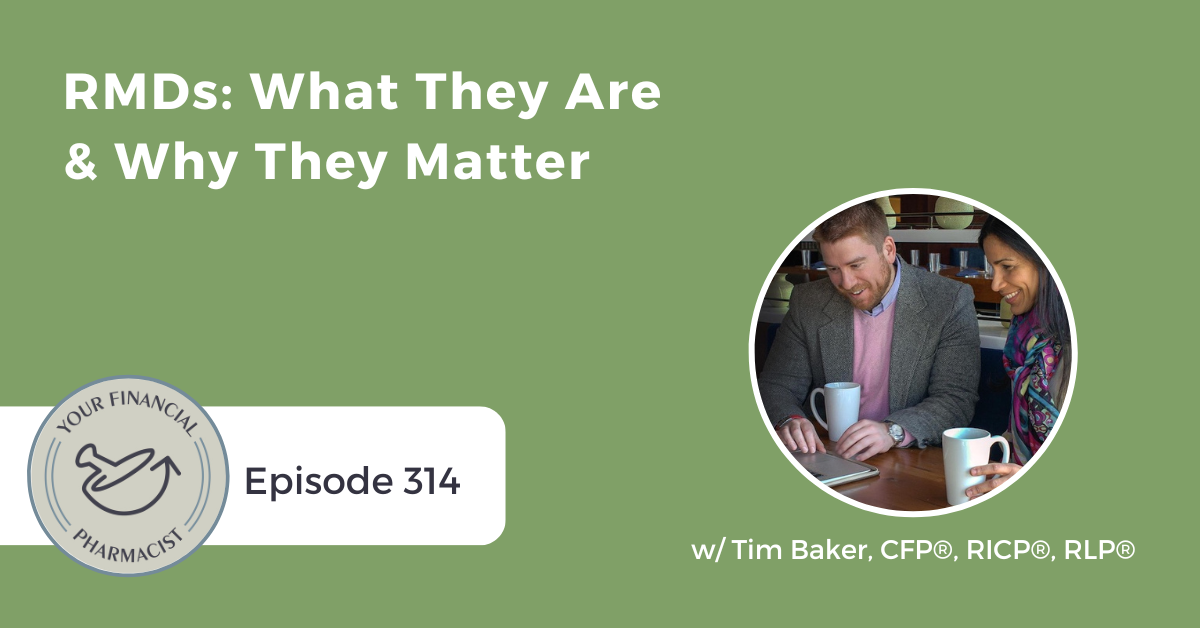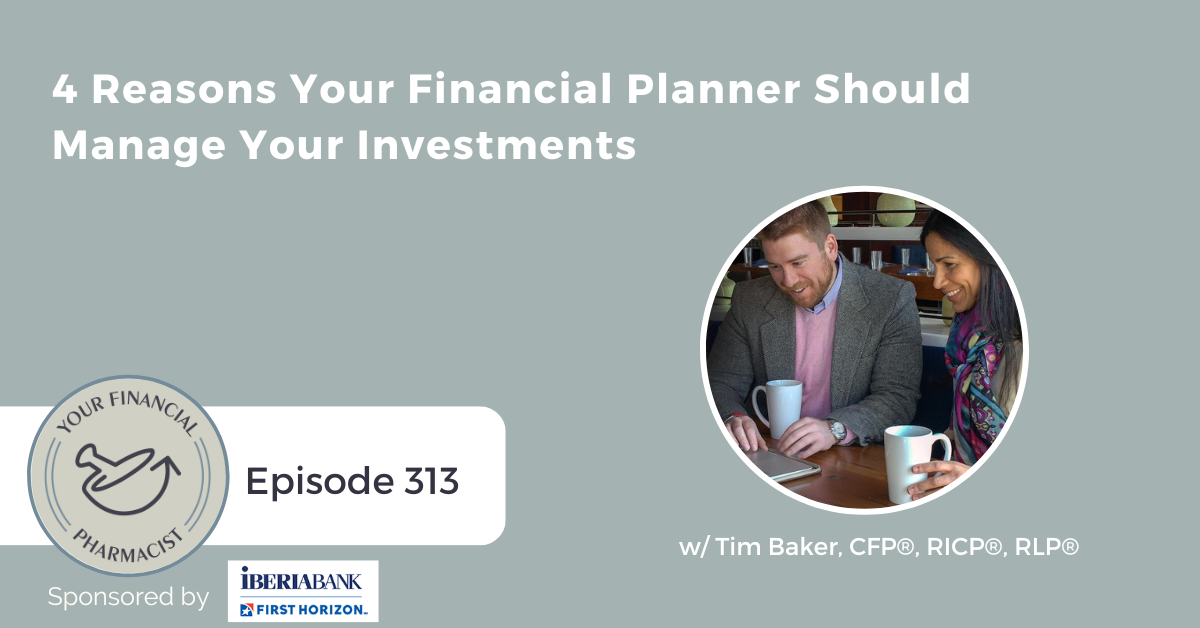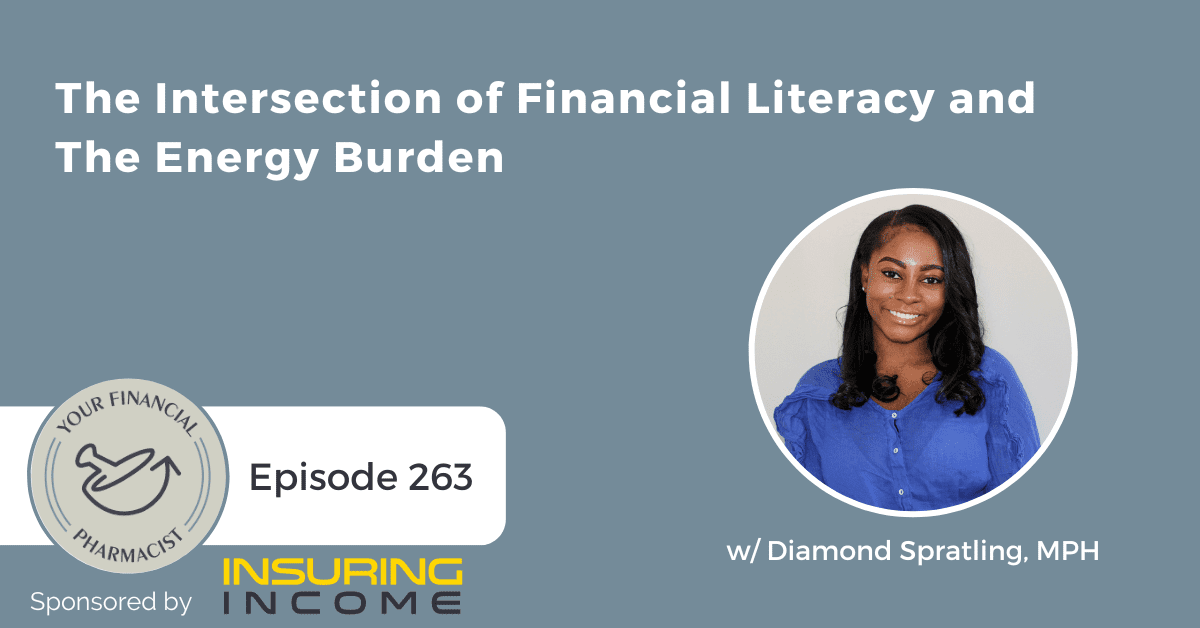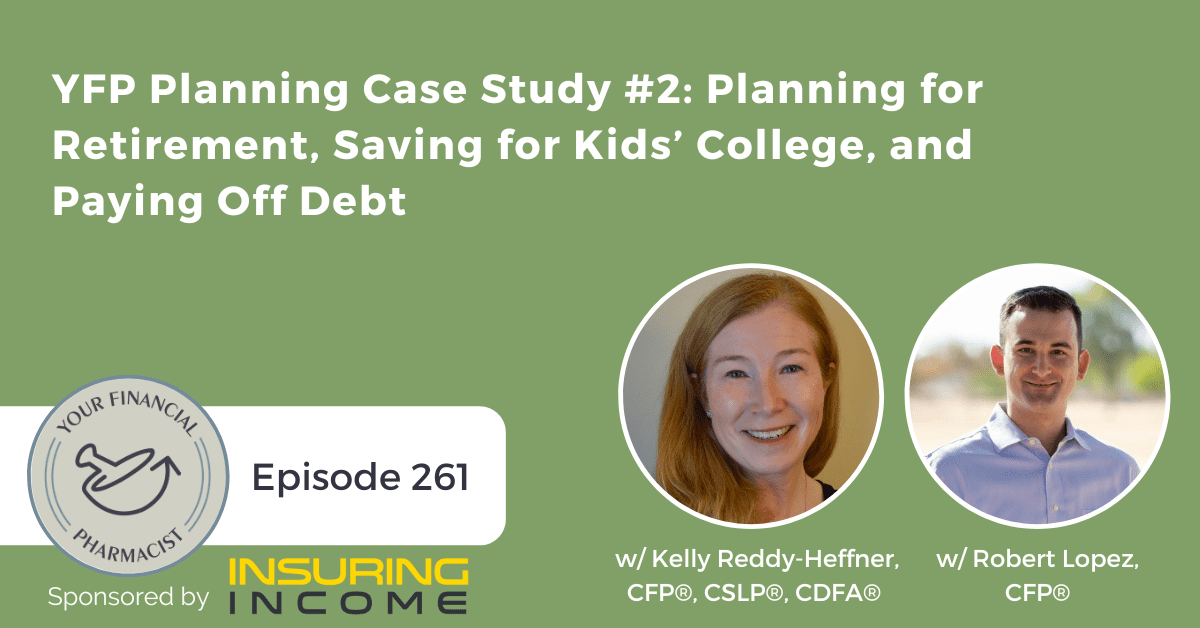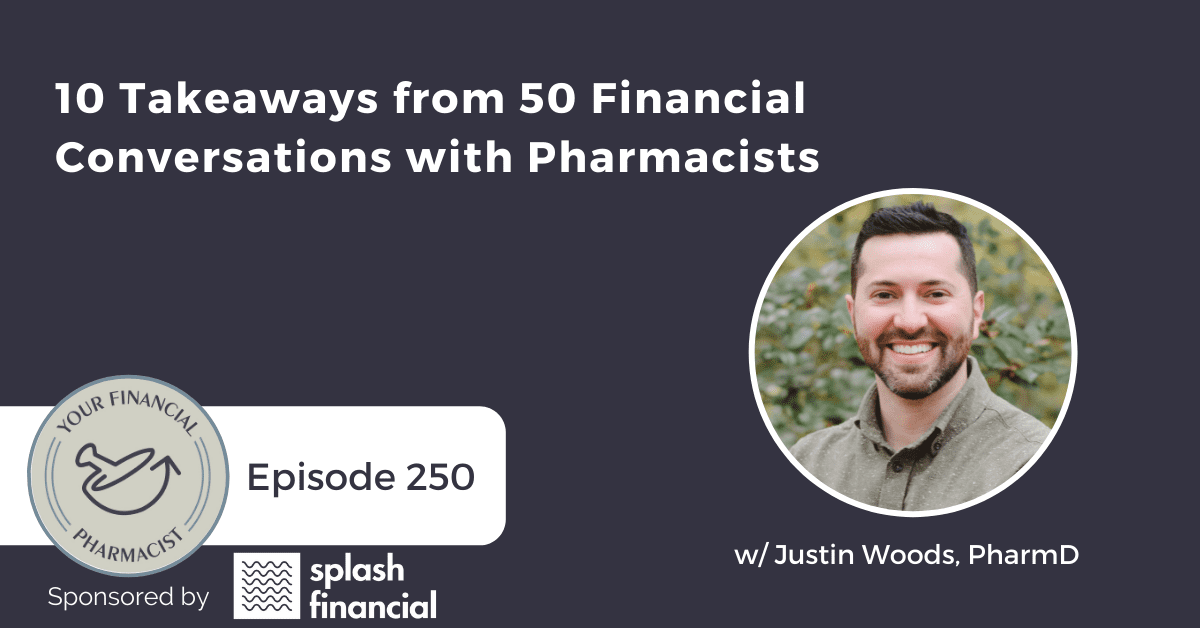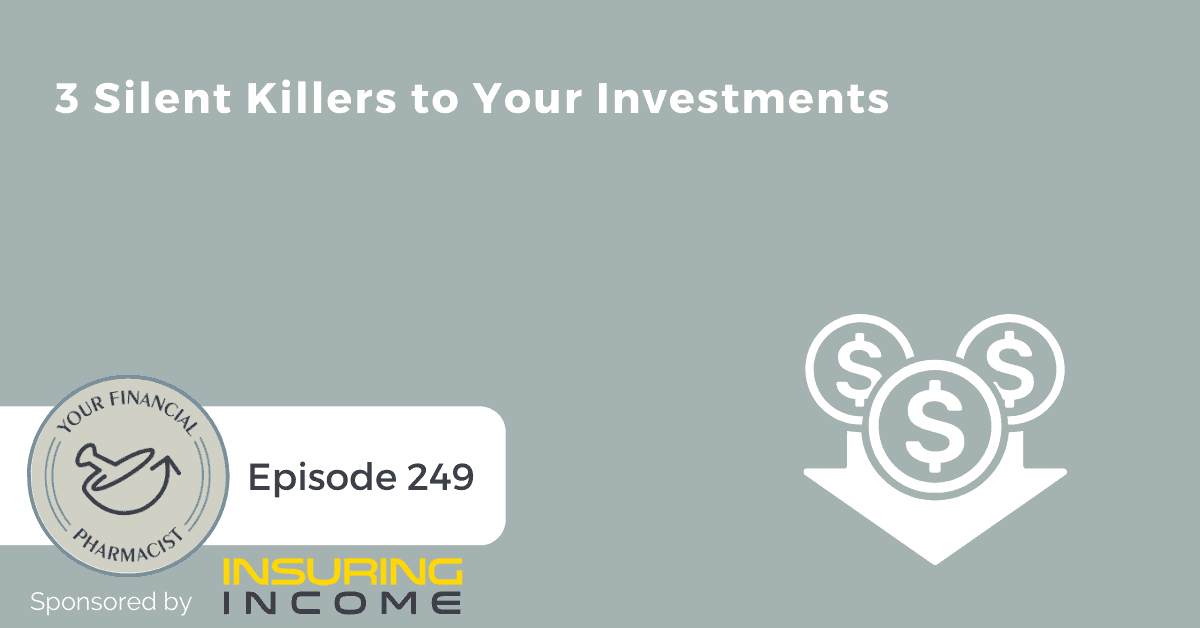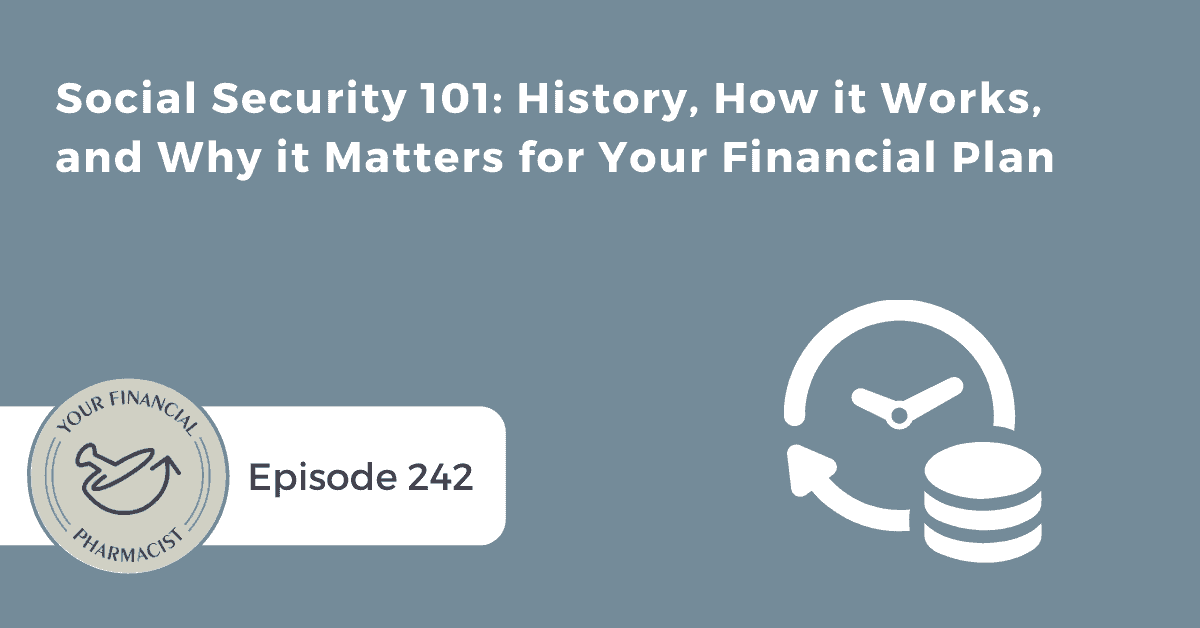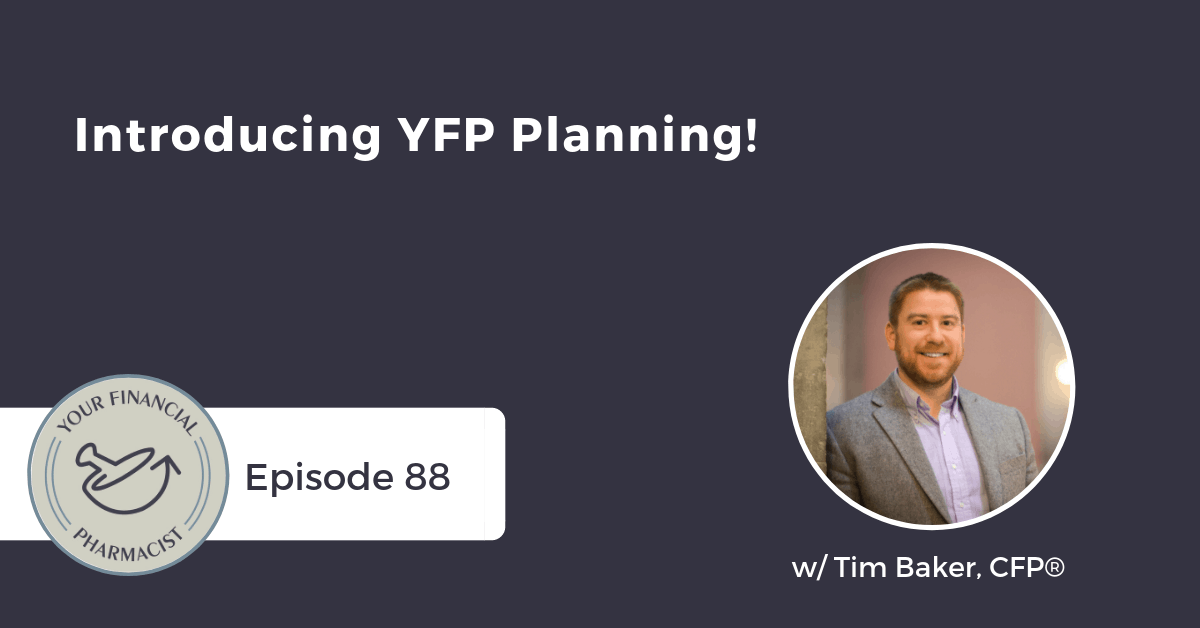Tim Baker, CFP®, RICP®, RLP® discusses RMDs: What they are, why they matter, and factors to consider when building a retirement paycheck.
Episode Summary
No matter where you are in your career journey, it’s never too early to start optimizing your retirement plan. One important factor to consider when building your retirement paycheck is Required Minimum Distributions (RMDs). RMDs refer to the minimum amount that you must withdraw from certain retirement accounts each year after reaching a certain age.
On this week’s episode, YFP’s Co-founder and Director of Financial Planning, Tim Baker, CFP®, RICP®, RLP® unpacks the many intricacies of RMDs, like which accounts demand RMDs, which ones don’t, and what to consider when planning how to build your retirement paycheck. You’ll learn about how RMDs are calculated, the penalties you can expect when you don’t fulfill RMD requirements, how to optimize and reduce the impact of RMDs, and why optimizing your retirement strategy starts in the accumulation phase.
Key Points From the Episode
- Introducing Tim Baker and today’s topic: Required Minimum Distributions (RMDs).
- Planning for retirement and the taxes you typically need to pay.
- The importance of understanding RMDs, even if you aren’t near retirement age.
- How the IRS defines RMDs and a run-through of the accounts that typically include RMDs.
- An overview of a Roth IRA and how it is contributed with after-tax dollars.
- How contributing after-tax dollars allows your retirement to grow tax-free.
- A rundown of what happens if you inherit a Roth account.
- The primary benefit of Roth accounts: control.
- Why traditional accounts are still beneficial despite RMDs.
- A breakdown of how RMDs are calculated in various scenarios.
- The rules and penalties if you don’t fulfill your RMDs.
- What to consider when planning how to build your retirement paycheck.
- Why optimizing your retirement strategy starts in the accumulation phase.
- How to optimize and reduce the impact of RMDs.
Episode Highlights
“The government doesn’t really care because they’ve already taken their bite of the apple. With Roth IRAs, and then Roth 401Ks, 403Bs (especially heading into 2024), you’re not required to take RMDs.” — @TimBakerCFP [0:10:53]
“With Roths, it’s about control. It’s the control of when you’re paying your taxes or a known quantity of what your tax bill is going to be but then it’s also [that] I don’t have the burden of being forced to distribute the account when I don’t want to.” — @TimBakerCFP [0:13:03]
“So much of building a retirement paycheck (and all this strategy we’re talking about) really starts with ‘in what buckets are you saving?’” — Tim Ulbrich [0:27:16]
“I would still advocate for the use of these accounts because the long-term benefits of having tax-deferred growth is a huge benefit. – I don’t want people to think ‘I don’t want to use these accounts because I don’t want to have to pay RMDs’.” — @TimBakerCFP [0:30:01]
Links Mentioned in Today’s Episode
- Free Checklist: What Issues Should I Consider When Reviewing My Investments?
- YFP 313: 4 Reasons Your Financial Planner Should Manage Your Investments
- Book a Free Discovery Call: YFP Planning
- Subscribe to the YFP Newsletter
- YFP Disclaimer
Episode Transcript
[INTRODUCTION]
[00:00:00] TU: Hey everybody, Tim Ulbrich here, and thank you for listening to the YFP Podcast, where each week we strive to inspire and encourage you on your path towards achieving financial freedom.
This week, I welcome YFP co-founder and Director of Financial Planning, Tim Baker, to talk about required minimum distributions. Also known as RMDs. We discuss what they are, how they’re calculated, strategies to optimize, and why this topic matters to building a retirement paycheck.
As a supplement to today’s episode, make sure to download our free checklist; What Issues Should I Consider When Reviewing My Investments? You get a copy of that resource by visiting yourfinancialpharmacist.com/investmentreview. Again, that’s yourfinancialpharmacist.com/investmentreview.
Okay. Let’s hear from Justin from the YFP team and then we’ll jump into my interview with Tim Baker.
[00:00:55] JW: This is Justin Woods from the YFP team with a quick message before the show. If you listen to the YFP podcast, you may learn something every now and then, either from Tim Ulbrich, Tim Baker or one of our guests. A lot of people listen to the show but they may not execute or implement the things they learn.
As pharmacists, we know the impact of non-adherence on patient outcomes and their overall well-being. As a pharmacist myself and part of the YFP team, I talk with pharmacists every day who are confused about how to implement financial knowledge. Pharmacists share with me that they’re treading water financially. Maybe took a DIY approach, reached the plateau and are confused about what to do next. Or those who work for decades can see the light at the end of the tunnel and feel uncertain about how the next chapter will unfold. If that sounds like you, one, it is not uncommon to feel that way. And two, does it make sense for us to have a conversation to see if YFP planning can help you? Visit yfpplanning.com or follow the link in the show notes to find a time that works for your schedule.
[INTERVIEW]
[00:02:01] TU: Tim Baker, welcome back to the show.
[00:02:03] TB: Good to be here, Tim. How’s it going?
[00:02:05] TU: It is going well. Last week we talked about four reasons that we believe you should have your financial planner manage your investments. Great episode. If you haven’t yet, check that out. I hope you will do so. We’ll link to that in the show notes.
This week we’re going to be talking about a topic that we have not really covered before at length or in depth. And that is around required minimum distributions or RMD.
Tim, maybe not the most exciting topic to talk about. But considering some of the questions that we’re getting considering some of the rule changes have come around this with the Secure Act and, obviously, an important part of the retirement planning, a topic that we need to address.
[00:02:43] TB: Yeah. It’s one of those overlooked things until you’re kind of right up against it, unfortunately. And we kind of talk about it at a high level more with regard to your investment assets and what has yet to be taken by Uncle Sam.
I always kind of talk through, if you have a million dollars in a traditional IRA, a million dollars in a Roth IRA and a million dollars in a brokerage account, like how much money do you have? And unfortunately, it’s not $3 million. Because at least in the traditional IRA, when that money goes in pre-tax, it’s tax coming out. So if you’re in a 25% tax bracket to keep the math simple, you have 750,000 of that and Uncle Sam has 250,000. So you’re in a partnership with Uncle Sam in that account.
The big difference or when where RMDs come into play is that, just like when we retire, or how we retire, or things like that, we’re not always in control of how that money is to be poured into retirement. And, essentially, what the government says is, “Hey, remember all of those years that you were able to defer? Now we’re kind of requiring you to distribute those assets over time based on a table in terms of how much you actually have to do or actually have to distribute.” So we’ll kind of talk about that in this episode.
[00:04:16] TU: Yeah. And I really do believe, while this is a topic that I think tends to focus more on those that are nearing retirement planning, to build that retirement paycheck. Really, for folks at all stages of their career, even if I’m early on in my journey, really understanding how RMDs can be helpful in understanding, as you mentioned, the different bucket than how you’re saving and even some of the early investing strategies. So stay tuned regardless of where you are throughout your career.
Tim, let’s start with the definition. What exactly is an RMD? Requirement minimum distribution?
[00:04:49] TB: So this is the minimum amount that you must withdraw from your retirement account each year. I think that’s how the IRS defines it. And essentially, what it means is that if you have that million dollars in your traditional IRA that we talked about, you don’t have to pour all million dollars out in one year and Uncle Sam gets 250,000 and you get 750,000. That’s just used for kind of illustrative purposes.
But depending on your age, you have to pour out a portion of that million dollars. And essentially, what it’s doing is it’s forcing you to pay the tax on those pre-tax retirement accounts. And this has moved over time.
I think, Tim, when I first started learning about studying for the CFP and things like that, the age four required minimum distributions was 17 and a half years old. Now it’s 72. And this is part of the changes of the Secure Act. It’s going to move to 73. And then I think starting in 2033, the age will be 75. That’s a benefit for us. Our required minimum distribution at present will be 75 years old.
What that means is that we can hold on to these investments in the tax-preferred account longer. Now what the government is saying is that, yeah, you could hold on it longer. We also know that you’re living longer. So that’s one of the things that you’re trying to do.
The accounts that are in question, Tim, that often require – not often but do require minimum distributions are the 401K, the 403B, the 457, the TSP, the traditional IRA, SEP IRA, SARSEP IRA and then the simple IRA. These are the ones. Again, most people don’t have SARSEPs these days.
And then what’s weird is most Roth accounts do not require RMDs, which is one of the main advantages of a Roth. However, today, in 2023, and this will change in 2024, if you have – with YFP, we have a 401K with YFP. Part of the dollars that I invest into our YFP 401K goes to a pre-tax, a traditional 401K. But a good chunk of my dollars go into a Roth 401K.
If I were 73 and I had a balance in that Roth 401K, technically, I would still have to take an RMD from that account. In 2024 and Beyond, RMDs will no longer be required from those designated Roth 401K, 403B. So another little quirk in the –
[00:07:34] TU: Tim, just to highlight that for a moment because I think that’s point of confusion that’s going on right now. Roth IRAs have been like that. If you have a million dollars in a Roth IRA, as you highlighted, the buckets, a little bit earlier, you’re not required to draw from that in terms of what would come out of it with taxes. And we’ll talk about how that could impact beneficiaries if that money was transferred here in a moment.
And so, really, the change you’re referring to is for what has been a more popular employer-sponsored account. We see more and more people that are in these Roth 401Ks or in Roth 403Bs. Where the Roth is a part of an employer-sponsored account. And up until – coming up in 2024, those would have required an RMD even though they had the Roth term. But that’s going to change. Correct?
[00:08:22] TB: Correct.
[00:08:22] TU: Okay.
[00:08:23] TB: Yep.
[00:08:24] TU: So will that be a part of it will, part of it won’t? I’m thinking about my situation, right? I’ve got all this Roth 401K money that’s sitting in that bucket that’s pre-2024 and then after 2024. So some of it will be subject to RMD. Some of it will not?
[00:08:43] TB: No. When you’re in retirement, the only thing that’s going to be subject to an RMD for you would be what’s in your traditional 401K and any – if you still have a 403B, if you have a 457, a traditional. So it won’t be – that rule, you’re not going to have to take a little bit out of the Roth in 401K in the future. No.
I guess, in 2024, no one will be taking any money out of a Roth 401K or 403B for the purpose of an RMD. It was just one of those weird rules that kind of just needed to be satisfied. And I think that was put into the Secure Act 2.0.
[00:09:21] TU: Got it. Okay. So talk to us about Roths. And one of the main advantages I often – I guess debates I often hear around Roth is the whole tax rate today, tax rate in the future. But I think what we don’t talk enough about is the benefit of Roth’s not being required to withdraw that money until after death. So not only not having an RMD, right? Which is a positive. But also, that there’s not a requirement of those monies being withdrawn. So tell us more about that.
[00:09:49] TB: Yeah. So as part of the Roth – and again, you think about it from the government’s perspective. So the government, although we joke inefficient and like why the heck are we doing this? Or why is it written this way? From the government’s perspective, they’re looking to access tax dollars where they can. And for a Roth, they’ve already taxed those monies.
A Roth IRA is contributed with after-tax dollars. Again, the example I use is if I make $100,000 and I put I put $5,000 into a Roth IRA, the government taxes me in that year as if I made $100,000. So I don’t get a deduction for that. So it goes in after-tax and then it grows tax-free.
As those investments – as that $5,000 grows to 10,000, 15,000, I’m not paying capital gains tax on those dollars. When I pour that out in retirement, that doesn’t hit my 1040. I don’t get a 10 – like I’m not reporting that as taxable income. So the government doesn’t really care because they’ve already taken their bite of the apple. With Roth IRAs and then Roth 401Ks, 403Bs, especially heading into 2024, you’re not required to take RMDs.
Now if you inherit a Roth. Say you inherit a Roth from a deceased spouse, essentially, what you’re going to want to do is roll that over into your name and then no RMD will be required. If you inherit a Roth, say, from like a parent or something like that or any type of non-spouse, typically, there is an RMD required and it’s typically over a 10-year timeline. And that’s just the kind of exhaust the legacy account and close that out.
That’s one of the major bene – so I think one of the major benefits of the Roth and probably not talked about it directly is control, right? Because in a Roth, you are controlling when you’re paying the taxes, today. Whereas in a traditional, it’s kind of you put your finger in the sky. You don’t really know what your tax – your marginal tax rate is going to be in the future. We have no idea.
The government, the Congress could say, “Hey, these are the new –” the IRS could say, “Hey, these are the new tax brackets.” They’re a lot more than what they are today. Or they could go down. I think most people think that taxes are going to go up. That’s one of the benefits of like, “Hey, pay the tax now and go from there.
But the other thing that often doesn’t get talked about is, if I’m going to retire in Florida, Tim, we know that Ohio – one of the reasons I put a lot of money into Roth now is because – because we’re business owners, one of the weird nuances is that we don’t get hit with taxes for the first set amount of dollars that we make as business owners.
Right now, I’m like, “Okay, that’s a good opportunity for me to kind of circumvent.” It’s almost like I live in Florida or Texas from a – but if I didn’t have that and I was going to retire to Florida or Texas, where I don’t have state income tax, and I’m going to pour that out then, then that’s another thing that we have to kind of consider.
With Roth, it’s about control. It’s the control of when you’re paying your taxes or a known quantity of what your tax bill is going to be. But then it’s also I don’t have the burden of being forced to distribute the account when I don’t want to.
That is a huge benefit to a lot of people, is being able to have control over the tax rate and the time. And again, that’s not to say that these traditional accounts are bad. They’re not. They’re good, in fact. But when we kind of get the question of like where should I have my money? It’s a little bit in pre-tax. It’s a little bit in after tax. And it’s a little bit in tax-free. And I think all of those are going to play an important part as you approach retirement.
[00:13:53] TU: Yeah. And Tim, I wasn’t aware of the difference between the spouse versus non-spouse with a Roth being passed on to a beneficiary.
[00:14:03] TB: They’ve changed those rules like recently too. Yeah. Because it used to have stretch. And the stretch IRAs and inherited IRAs. And there’s lots of different nuances with that. And even the rules around inherited IRAs are pretty complex. Like they’re not straightforward if you’re an entity, versus a non-spouse, versus a spouse, versus keeping it in the decedent’s name or your name. There’s lots of different things that are going on there.
[00:14:31] TU: This too is another example we just talked about in the last episode of how we don’t want to look at any in a silo, right? For our younger practitioners who are listening that may be working through something like a student loan, forgiveness strategy, right? Implications here of traditional versus Roth contributions on the student loan equation.
We’ve talked about that before. We don’t need to go down that rabbit hole now. But when we talk about like Roth or traditional, another example yet where it’s not just a blanket, this one is better than the other, right? It really does depend in someone’s whole situation.
[00:15:03] TB: Yep.
[00:15:04] TU: Tim, how are the RMDs calculated?
[00:15:07] TB: The required minimum distribution for any year is – essentially, the way I learn this is that you look back for the balance. So this is the balance of your 401K, your IRA, your SEP IRA. So you look back at 12-31 of 2022 as an example. And then you look ahead, essentially, the year of – so if I’m turning 76 this year, that I look at that year as the year that I need for the IRS’s uniform lifetime table.
What do I mean by that? Let’s do an example to kind of flush this out. Let’s pretend it’s June 2023, which it is. And I’ve just turned 76. Or I’m about to turn 76. Essentially, when I look at age 76, the IRS uniform lifetime table returns a column. It’s distribution period in years of 23.7.
As a 76-year-old, essentially, I have 23.7 years to distribute the account out. So that’s the factor that I use. I go and I pull my statement from the end of last year and I see that, in my traditional IRA, I had $250,000. I take that $250,000 and then I divide it by that factor from the IRS table as a 76-year-old. $250 000 divided by 23.7. And it says that my required minimum distribution for that year is $10,548.52.
That is what I’m required to distribute to kind of – to not be penalized by not taking the proper RMD. Essentially, I would work with my advisor and I would say, “Okay, at a minimum, I need to, either in a lump sum or in payments over the course of – we would probably just build this into the retirement paycheck. That, hey, we need to essentially allocate this amount of cash from the IRA and make sure that that satisfies the RMD requirement. That’s the first example, Tim. Did you have a question?
[00:17:18] TU: Yeah. And so, in that example, 10,548, right? You mentioned $50,000 balance in your traditional IRA. [inaudible 00:17:25] 10,500, that would be the required minimum distribution. That 10,500 is then taxed as ordinary income, correct?
[00:17:34] TB: Correct. If the custodian is what we use that TD Ameritrade, which is TD Schwab. Essentially, TD Schwab would send me a 1099R and it would show that distribution. And essentially, I would be working with Sean, my CPA, when I go to file my taxes. And that would show up as income. I might still have some W2 income or I might have some other 1099 contract income of doing some consultant and when I’m 76. Maybe I’m doing that for YFP in the future.
I might have some W2 income. I might have some 1099 income. And then this 1099R our income would be recorded on my taxes. And then depending on what tax bracket I’m in, that’s when I would be taxed.
Right now, if I’m in a 25% tax bracket versus maybe when I’m 76 – I know I’m conflating years and everything. But maybe when I’m 76, maybe I’m in a 12% tax bracket. So that would be benefit to essentially – let’s say I’m earning less than $90,000, which is the 12% bracket for married filing jointly. That’s kind of what’s at play here. You basically get the 1099R and record it in your taxes in that year.
[00:18:50] TU: Okay. Got it.
[00:18:52] TB: Another example of this is let’s pretend, Tim, that I have a traditional IRA, a SEP IRA and a 401K. Same fact pattern. It’s June 2023. I’ve just turned 76. And that distribution period in years is still 23.7. When I look at my statement, I see that, okay, I still have the $250,000 IRA. But I also have $100,000 in my SEP IRA and I have $500,000 in my 401K.
My RMD this year, if I take 250,000 and divide it by 23.7, it’s still at 10,548. The SEP IRA, $100,000 divided by the same factor, 23.7. The RMD for that is now $4,219.41. That’s still in addition to the 10,500 from the traditional.
And then the 401K of half a million dollars I have to distribute. So, $500,000 divided by 23.7. I have to distribute 21,000. We’ll call it 21,1000. $21,000. My total RMD across all three of those accounts is $35,865.
Now just to make this even more complex, Tim, with the traditional and the SEP, I could take all of that out of my traditional. That’s the bigger account. Or I could take that all out of the SEP if I wanted to. With the 401K, I have to take it out of the 401K.
Or let’s say I had a 403B. I would have to take it out of the 403B. So those that are administered by the employer, or in my case, a previous employer, I have to take it out of those plans if I have those IRAs that I’m managing. Or an advisor is managing for my benefit, I can aggregate those and have that come out of one. That’s one of kind of the nuances there.
[00:20:53] TU: That makes sense. So the I in IRA is an individual account, right? It stands for individual. In that example, we had a traditional and a SEP. You could take the RMD out of one of those accounts. Either the tradition or the SEP. But since the 401K was an employer-sponsored account, that RMD has to come directly out of that account.
[00:21:11] TB: Yep. Correct.
[00:21:12] TU: Okay. Got it. So we’re going to talk in a little bit about why this topic really matters and some of the strategies to reduce CRMDs. But let’s talk about the penalty side of this. What happens if, Tim, I don’t take an RMD? So maybe I’m not familiar with the rules. I’m DIYing this and just not paying attention to logistics or something gets overlooked. What happens in that case?
[00:21:33] TB: In the old rules, before the Secure ACT 2.0, it would be basically 50% of what you fail to take that would be taxed. In the case that I was saying, it’s like if I had to take 10,500, 5,200 of that would be basically the penalty. And then you’d have to file form 5329 in your federal tax return for the year that the RMD was not taken.
With the new rules, it’s basically they tried to make this less – they try to soften this a little bit. So now it’s 25%, which is still substantial. And then if you correct it within two years, it’s 70 – it’s 10%. Excuse me. One of the things – again, one of the weird nuances is let’s say I’m turning 72 this year. Technically, I don’t have to take the R in the first year. Don’t ask me why is this, Tim. In the first year, I don’t have to take the RMD until April of next year.
But then every subsequent year I have to take it before the end of the year. Let’s pretend I say, “Oh, I didn’t take it. I’m taking it April 15th right before I file my taxes.” But then in that same – if I have to take that 10,500. In that same year, I have to take another RMD for 73. That’s another one of the weird nuances. Yeah, it’s 25%. But 10% if it’s corrected within the first two years.
[00:22:54] TU: I mean, even 10% is no joke though, right?
[00:22:58] TB: Yeah. I mean, some of these rules is like if you over contribute, it’s like a 6% excise. When you go from 50% even down to 25% or 10%, it’s – and the dollars get bigger. I mean, your balances are supposed to get smaller. But every year – so when you go from like 76, where the factor is 23.7, the next year at 77, it’s 22.9.
And one of the things that the IRS has done is they extended it out. I think it goes all the way up to like age 120 and older. But at 110, as an example, the factor is 3.5. If you have a million dollars at 110, about $300,000 and $400,000 is what you have to distribute in that year. The factors get smaller, which means that the RMD gets bigger as you age. Again, if you’re not doing it properly, the penalties can be quite robust.
[00:23:54] TU: Whether we like the rules or not, Tim, they are what they are, right? We’ve got to factor them in. We’ve got to plan for this. And my mind is spinning around, “Okay, I’ve got all these different buckets of funds that I’ve been building throughout my accumulation phase.” Right? We’ve talked about some of the alphabet soup here in this episode. And now there’s this strategy of how I withdraw not only from those buckets. But also, how do I factor in the RMDs? And in which order? Which priority?
At the end of the day, the topic matters, I think, as you try to build a retirement paycheck and think about the order of withdrawal and how you’re going to put together that paycheck in retirement.
[00:24:33] TB: Yeah. I mean, if you look at what are the sources of income that you’re going to have in your retirement paycheck, one of the big ones is going to be Social Security, which, as we continue to go on, more and more people, their Social Security will be taxed. Because a lot of the phase-outs for that have not been adjusted for inflation.
But if you think about it, the average today, Social Security check, per month, per recipient, it’s like $1,780. Just about 21,000 and change per year. That might be your baseline. And then for most people, if I need $80,000, then 60,000 is going to come from your traditional investments.
And what we’ve seen here is, in this example, 35,000 of that has – in this example, has to come from the traditional, right? So then you’re playing the game of like, “Okay, if I’m trying to get to 60,000, that still puts me in a 12% tax bracket.” Again, if I’m just looking at myself and not necessarily Shay.
What is she getting from Social Security? What does her RMD look like? Are we going to try to fill up the 12% tax bracket? Are we looking at the 225 tax bracket? Are we pulling anything from Roth at all?
I think, again, having the ability to pull from pre-tax, you have to, especially with the RMDs. But then to then move to something like a brokerage account, which is after tax to a tax-free, which is a Roth. All of those things are going to be in play to make the most efficient play at building a retirement paycheck.
And depending on where – again, if you have certain assets in certain accounts, they are not going to be optimized with kind of the strategy. You have to be wary of that too. What are the things that are going to be most volatile or higher risk, higher return? Most capital gains, things associated with that. Those are all going to be important when you’re kind of building this out.
Is there an annuity? A lot of annuities if you buy a qualified annuity. If you take some money out of your traditional IRA, so to speak, to buy an annuity, those have RMDs. And a lot of that can satisfy the RMD or delay it. There’s some strategies there. There’s lots of tax implications. But also, how does this relate to your investment allocation? The location of certain assets? It’s all very nuanced.
[00:27:10] TU: Yeah. And Tim, the place that I’m thinking about right now, I’m 15 years into my career. I put myself in that mid-career bucket. But so much of building a retirement paycheck and all this strategy we’re talking about really starts with ‘in what buckets are you saving’, right?
I think sometimes there’s a tendency that, “Hey, we need to save whatever big number.” Right? Two, three, four million dollars. And we just start saving, saving saving.
And saving is good, especially if we’re doing it over a long period of time. But saving intentionally so that we’re thinking about this from a distribution sense, I think we often disconnect that accumulation and decumulation phase. And, really, prioritizing that. Really, the accumulation, optimization, and the strategy around that, especially in a tax-efficient way, really starts back in the accumulation phase.
[00:27:58] TB: Correct. Yeah. It’s kind of building – we talked about building a foundation of an emergency fund and getting the debt – the consumer debt in line and having a plan for this student loan. But this is right there in terms of, again, bucket selection. But then inside of those buckets, what assets are we actually put in? And are they the best for the long run? Yeah, those are definitely in play.
And again, I think it’s often an overlooked thing. And this is where – and again, it’s not necessarily like if you’re required to distribute your account, that doesn’t necessarily – it doesn’t mean that you have to consume it. You can always direct those dollars elsewhere. Whether it’s a brokerage account or it could be real estate. It could be paying for a grandkid’s education or something like that. There are things that you don’t necessarily have to like move those dollars off your balance sheet.
But, essentially, what’s in play here is the efficiency related to tax. And, again, in the context of like, “Okay, what is it that I need to sustain a retirement paycheck for from now until age 95, 100, 105, 110?” And that’s difficult to do.
[00:29:13] TU: Yeah. And I’m thinking about this from a household perspective, right? Tim, you mentioned you’ve got, often, two people, multiple accounts. So now you’re talking about additional layers of complexity. Maybe different timelines of retirement and when they need those funds and goals that they have. This is where I really want for Jess and I. I want the two of us with our CFP and the CPA in the same room whiteboarding and kind of masterminding this to make sure that we’re really thinking about it from every angle.
[00:29:43] TB: Yep.
[00:29:45] TU: Finally, I know many of our listeners are thinking what I’m thinking, which is, “Hey, what can we do to optimize this? What can we do to potentially reduce the impact of the RMDs?”
[00:29:55] TB: Yeah. So there are a few things. RMDs are inevitable, right? If you use any of these accounts – and again, I would still advocate for the use of these accounts because the long-term benefits of having tax-deferred growth is a huge benefit. I don’t want to say it’s not. I don’t want people to think I don’t want to use these accounts because I don’t want to have to pay RMDs.
There’s a few strategies that you can employ. If you are still employed and you’re kind of within that RMD age. Let’s use 72, 73. You can delay your 401K RMDs. Not necessarily your IRA RMDs. But your 401K RMDs from your employer until you retire. You just can’t be a 5% owner, Tim, for you and I. Like that wouldn’t imply. We would still have to take RMDs.
Probably one of the biggest things that you can do is just get money out of those buckets. So this would be things like Roth conversions. Essentially, over your career, you can identify times that it makes sense because of lower earning years. You’re still paying the taxes on it. But you’re doing it in more of a controlled way versus here’s the balance, here’s the factor, and then that’s your RMD.
One way that you can do it is just manage the distribution. So most people take RMDs either in a series of payments or through like a lump sum at the end of the year. One strategy that you can, which, again, we bring up annuity, which is sometimes a bad word for people. But you can invest in a QLAC.
A QLAC is a qualified longevity annuity contract. This is the deferred fixed annuity that you purchase with funds from your retirement account. Like a traditional 401K or a traditional IRA. And typically, because there is a promise in the future to pay out those funds, one of the special things about this is that there’s no required distributions until 85. Until age 85. You can push that out for a decade or so.
The big selling point for this is, if you’re looking at – in the example I gave, “Hey, I had $500,000 in my 401K.” And that means that the RMD for this year is 21,000. I really don’t want to do that. I can peel off 100,000 or 200,000 and put that into a QLAC. And that lessens the burden from what’s coming out from the 401K. That is a strategy that you can use.
Charitable donations. So you can either – you can do this one of two ways. And I think it just depends on the tax situation. You can make a QCD, a qualified charitable distribution, which is a direct transfer from your retirement account right to a qualified charity. And this will be basically excluded taxable income, which will lower your tax bill. Or you can use your RMD to make charitable donations and kind of get a – that’s typically where, again, you’re going to use the itemized deduction and maybe want to do a bunch in strategy or things like that to get the most benefit. So those are ways to kind of reduce or delay or get around the RMD, which at the end of the day is inevitable.
[00:33:17] TU: Tim, great stuff. I feel like we’ve covered a lot of length in a short period of time a topic, again, that we haven’t talked about in great detail. We’ll certainly be coming back to this more as we talk about some of the retirement planning strategies. But again, a great episode regardless of what stage of career that you’re in.
For those that are listening and say, “Hey, I’d love to have someone in my corner really thinking about this from an investment, retirement planning strategy,” we’d love an opportunity to talk with you further about the financial planning services that we offer at YFP planning. You can learn more and book a free discovery call at yfpplanning.com. Again, that’s yfpplanning.com.
Tim, great stuff. We’ll be back here in the future.
[00:33:57] TB: Thanks, Tim.
[OUTRO]
[00:33:58] TU: As we conclude this week’s podcast, an important reminder that the content on this show is provided to you for informational purposes only and is not intended to provide and should not be relied on for investment or any other advice. Information in the podcast and corresponding materials should not be construed as a solicitation or offer to buy or sell any investment or related financial products. We urge listeners to consult with a financial advisor with respect to any investment.
Furthermore, the information contained in our archived newsletters, blog posts and podcasts is not updated and may not be accurate at the time you listen to it on the podcast. Opinions and analyses expressed herein are solely those of your financial pharmacists unless otherwise noted, and constitute judgments as of the date publish. Such information may contain forward-looking statements are not intended to be guarantees of future events. Actual results could differ materially from those anticipated in the forward-looking statements. For more information, please visit yourfinancialpharmacists.com/disclaimer.
Thank you again for your support of the Your Financial Pharmacist podcast. Have a great rest of your week.
[END]
Current Student Loan Refinance Offers
Note: Referral fees from affiliate links in this table are sent to the non-profit YFP Gives. | Bonus | Starting Rates | About | YFP Gives accepts advertising compensation from companies that appear on this site, which impacts the location and order in which brands (and/or their products) are presented, and also impacts the score that is assigned to it. Company lists on this page DO NOT imply endorsement. We do not feature all providers on the market. |
$750* Loans ≥150K = $750* ≥50K-150k = $300 | Fixed: 4.89%+ APR (with autopay) | A marketplace that compares multiple lenders that are credit unions and local banks | ||
$500* Loans ≥50K = $500 | Variable: 4.99%+ (with autopay)* Fixed: 4.96%+ (with autopay)** Read rates and terms at SplashFinancial.com | Splash is a marketplace with loans available from an exclusive network of credit unions and banks as well as U-Fi, Laurenl Road, and PenFed |

